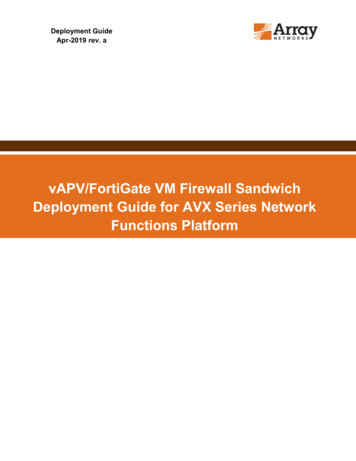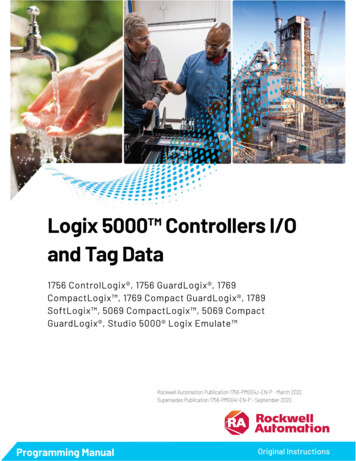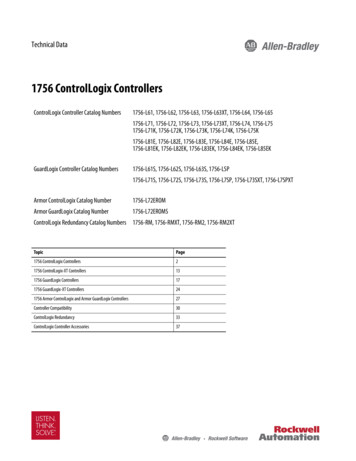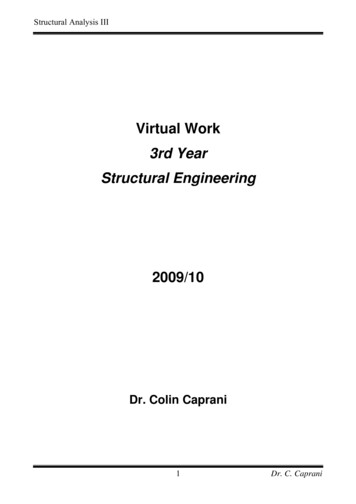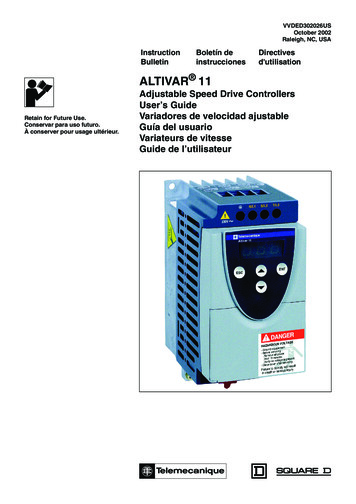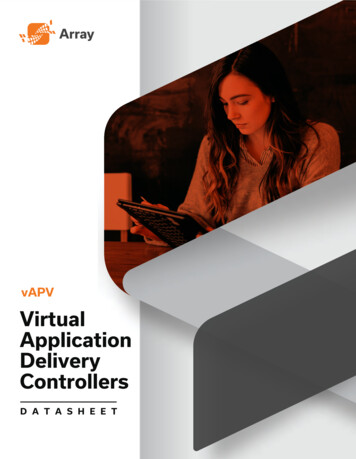
Transcription
vAPVVirtualApplicationDeliveryControllersD A T A S H E E T
vAPV Virtual Application Delivery Controllersimprove application availability, performanceand security while enabling dynamic,flexibleand elastic provisioning in cloud and virtualenvironments.Powered by Array’s 64-bit SpeedCore platform, vAPV virtualapplication delivery controllers extend Array’s proven applicationavailability, acceleration and security capabilities to virtualized datacenters and public/private clouds. Combining the application deliveryand traffic management features common to all APV Series productswith the flexibility afforded by a virtualized infrastructure, vAPV virtualapplication delivery controllers enable dynamic pay-as-you-growscalability and new elastic business models for both development andproduction environments.
Highlights And BenefitsVirtual appliances with a software upgrade fromone to eight virtual CPUs to scale-up and scale-outas needed; alsoavailable on popular public cloudmarketplaces such as AWS and AzureIntegrated Layer-4 and Layer-7 server loadbalancing, link load balancing, global serverload balancing, connection multiplexing,SSLacceleration, caching, compression, traffic shaping,DDoS protection, IPv6 and web application securityHigh-performance, kernel-level Layer-7 policyengine for enabling customizable application trafficmanagement without impactingperformance or scalabilityIndustry-leading performance and /SSL TPSfor 2048-bit SSL with advanced client certificatehandling for secureapplication support and easyapplication integrationMulti-level security including a hardened OS,reverse-proxy architecture and kernel-level webfirewall for guarding applicationswithout impacting performanceServes as a SAML SP for web Single Sign-On (SSO)to authenticate and streamline user access to web-based and otherapplicationsDelivers 99.999% application availability, up to 5xapplication acceleration and provides a first line ofdefense for web-enabledapplications and cloudservicesSoftware SSL offloading from web and applicationservers, and optional hybrid virtual/dedicatedhardware SSL offloadingIntercepts and decrypts/re-encrypts SSL traffic for3rd-party security appliancesIntelligently load balances traffic across optimalWAN links to reduce costs and improve theperformance of business-critical applicationsApplication-specific certifications, guides andpolicies for rapid deployment and accelerateddelivery of business-criticalenterprise applicationsePolicy L7 application scripting and eRoute L4routing for custom control of application trafficIPv6 gold certified for IPv4 preservation, IPv4/6translation and IPv6 migrationArray eCloud RESTful API and XML-RPC forseamless interaction with cloud managementsystems and 3rd partymonitoring solutionsIntegration with VMware vRealize Orchestrator andMicrosoft System Center, as well as OpenStackloadbalancing-as-a-service (LBaaS)N 1 clustering for up to 32 virtual instances, singlesystem image and stateful TCP failover for industry-leadingavailability and scalabilityFamiliar CLI, intuitive cloud-friendly WebUI andcentralized management for ease of use andconfiguration
FeaturesAble to integrate seamlessly with cloud management systems for automatedservice provisioning, vAPV virtual application delivery controllers are the idealchoice for enterprises, service providers and other seeking scalable and flexibleapplication delivery and load balancing with the ability to improve data centerefficiency and enable profitable cloud service offerings.vAPV virtual ADC appliances include all features and software modules foundon Array’s APV Series application delivery controller dedicated appliances.Server Load BalancingvAPV virtual application delivery controllers ensure 99.999% availability for cloud services and enterpriseapplications. Leveraging robust distribution algorithms, health check mechanisms, clustering and failovercapabilities, vAPV virtual appliances maintain connections, ensure persistence, direct traffic away from failedservers and intelligently distribute application services across multiple servers for optimized performance andavailability. APV Series can load balance traffic for a wide variety of protocols at Layers 2, 3, 4 and 7, includingWebSocket.Layer-7 Policy EngineCustomized traffic management is often a trade-off between performance, control and ease-of-use. UnlikeADCs that rely on complex, compute-intensive scripting to enable custom Layer-7 policies, Array supports avast library of policies that are hard-coded at the kernel level, are configurable with point-and-click simplicity viathe WebUI or CLI, and can be combined and nested to create advanced customized application trafficmanagement. With Array’s unique approach to Layer-7 traffic management, customers get the best of allworlds: ease of use, granular control and superior performance and scalability.2048-Bit SSL OffloadingSSL offloading reduces the number of servers required for secure applications, improves server efficiency anddramatically improves application performance.Offloading compute-intensive key exchange and bulk encryption, and delivering industry-leadingclient-certificate performance, SSL acceleration is ideal for scaling secure SaaS services, e-commerceenvironments and business-critical applications requiring high-volume secure connectivity.Although more secure than the old 1024-bit standard, 2048-bit keys are five times more compute intensiveand can impact both performance and the cost of supporting applications. Array 2048 and 4096-bit software(or optional hybrid) SSL encryption offers unbeatable scalability and performance with the lowest cost per SSLTPS to offset transition costs and improve security without impacting performance.
SSL InterceptSSL-encrypted data traffic is increasing rapidly, which can place data centers and enterprises at risk – in manycases, encrypted traffic cannot be inspected by security appliances such as firewalls, IDS/IPS, data lossprevention and deep packet inspection, thus bypassing these important security measures.Array’s SSL Intercept capability decrypts SSL traffic, allowing 3rd-party appliances to inspect them fully, thenre-encrypts before forwarding the traffic to its destination. Flexible deployment options include L2 or L3 mode,integrated or distributed mode, forward or reverse proxy, and load balancing across multiple 3rd-partysecurity appliances. In addition, an APV Series ADC can operate as a Webagent service to implement explicitforward proxy mode.WebWall Web Application Firewall and DDoS ProtectionWith WebWall , Array’s suite of web application security capabilities, vAPV virtual application delivery controllerscan protect against distributed denial of service (DoS/DDoS) and malformed URL attacks, and allow a wide rangeof Layer 2 through Layer 7 protective policies to be stacked atop one another for increased security.vAPV virtual appliances are security-hardened to protect applications and servers from L4 and L7 DDoS attacksand support content filtering to guard against protocol and application DDoS attacks as well as Syn-flood, teardrop, ping-of-death, Nimda, Smurf and other malicious attacks. vAPV appliances also feature extensive accesscontrol lists, network address translation and stateful packet flow inspection – all executed at the kernel level – toguard againstattacks and unauthorized access without impactingperformance or scalability.In addition, integrated web application firewall capabilities provide deep application data inspection – beyond IPand TCP headers – to deal with attacks such as SQL injection and cross-site scripting. Deployable in front ofmultiple web or application servers, Array’s web application firewall detects and responds to signatures forknown application vulnerabilities and is programmable to deal with future threats.Secure Application AccessWeb-based and other applications typically require secure authentication in order to grant access to users;however, when users require access to multiple applications, or applications include subsystems that also requireauthentication, the process of logging in can become cumbersome and difficult.The APV Series supports Security Assertion Markup Language (SAML) to allow user Single Sign-On (SSO) acrossmultiple applications and subsystems. Serving as a SAML SP, the APV Series interacts with a SAML IdP (such asArray’s AG Series SSL VPN) to securely authenticate the user, thus simplifying and streamlining access.
Link Load Balancing & GSLBLink load balancing (LLB) and global server load balancing (GSLB) ensure 99.999% availability for wide areanetwork (WAN) connections and geographically dispersed sites and hybrid cloud environments. Link loadbalancing with end-to-end health monitoring and dynamic routing detects outages and monitors performancein real time to distribute traffic across multiple WAN connections for a premium, always-on end-userexperience. Ideal for geographically distributed applications, multi-site architectures and hybrid cloudapplications, global server load balancing directs traffic away from failed data centers or cloud services andintelligently distributes services between sites based on proximity, language, capacity, load and responsetimes for maximum performance and availability.Application AccelerationvAPV virtual appliances leverage multiple acceleration technologies and optimizations to deliver a premiumend-user experience for a wide range of applications and data services. In-memory caching increases serverefficiency and improves seek and response times by over 500%, software compression can reduce bandwidthutilization and end-user response times by more than half and TCP connection multiplexing aggregates millionsof short-lived client connections into persistent fast lanes that increase server efficiency by up to 70% whileimproving application performance.ePolicy L7 Application ScriptingWhere Array’s Layer-7 policy engine cannot meet application traffic management requirements, ePolicy scriptingallows transactions and content to be manipulated to achieve traffic distribution that improves data centerefficiency and mitigates the effect of delivering applications over the internet.eRoute L4 RoutingUsing eRoute, inbound and outbound WAN traffic may be load balanced across multiple ISP links based on presetand user-defined algorithms and directed across routes optimized for maximum stability and performance.Additional L4 traffic management features include VLANs, port forwarding, port and link redundancy and the abilityto bundle multiple low-cost links to improve bandwidth utilization and reduce costs.Application-Specific CertificationsIn conjunction with ISVs and application developer partners, Array vAPV virtual appliances have been certified toprovide load balancing, acceleration and security for enterprise applications such as Microsoft Lync 2010 and 2013,Microsoft Exchange 2010/2013/2016, SAP, Oracle, eClinicalWorks and others. Leveraging deployment guides,businesses can take the guesswork out of application delivery. Following simple step by step instructions, IT canrapidly and confidently configure vAPV appliances for optimized delivery of business critical applications.Traffic Shaping & QoSTraffic shaping optimizes application traffic on WAN links to improve bandwidth utilization and end-user responsetimes. Supporting user-defined policies, vAPV virtual appliances prevent bandwidth-intensive applications fromoverutilizing WAN links and ensure essential applications are prioritized to meet service level agreements. Used inconjunction with link load balancing, global server load balancing and QoS features such as filters and class-basedqueuing, traffic shaping can dramatically improve application performance.
IPv6 SupportFor organizations needing an IPv6 web presence, server load balancing protocol translation (SLB-PT) transformsexisting IPv4 web sites into IPv6 compatible sites and greatly reduces the need for duplicate equipment, contentand management. Where there is a need to make the most of depleted IPv4 resources, NAT and dual NAT(dual-stack IPv6) allow multiple clients to utilize a single IPv4 address. In migration environments, Array IPv6solutions support both NAT64 and DNS64 to enable IPv6 clients to connect with IPv4 servers and content. Toensure a consistent application experience across IPv4 and IPv6 clients and networks – and to enable fully-capable,next-generation solutions – IPv6 feature parity is supported for all Array vAPV virtual application delivery controllers.Management & IntegrationvAPV virtual application delivery controllers are simple to install and offer intuitive configuration andmanagement via a cloud-friendly, intuitive WebUI and a familiar command line interface. Using theadministration tool kit, network managers can view the status for a wide range of system parameters, enableservices on the fly and automate configuration using XML-RPC or RESTful API. Leveraging extensible APIs,application and network intelligence can be integrated with third-party and cloud monitoring and managementor exported for optimizing complementary data center systems. In addition, vAPV virtual appliances supportVMware vRealize Orchestrator and Microsoft System Center integration for intelligent command and control ofvirtualized application infrastructure.eCloud API & OpenStack IntegrationTo meet the deployment and management requirements of load balancing and application delivery in the cloud,Array’s eCloud API provides a script-level interface for cloud management systems to manage and monitor Arraydevices and assist in interactions between cloud operating systems and virtual machines running Array loadbalancing. For cloud providers and enterprises leveraging the OpenStack architecture for cloud management andautomation, Array’s integration with OpenStack load balancing-as-a-service (LBaaS) creates a standardized meansto rapidly integrate with and control Array technology.Product EditionsvAPV virtual appliances support a rich server load balancing and application acceleration feature set optimized forlocal traffic management. In addition, software SSL acceleration combined with server load balancing andapplication acceleration create a traffic management solution ideal for SaaS, ecommerce environments andapplications requiring a high degree of secure connectivity. vAPV virtual appliances also include link load balancingand support global server load balancing as an option.Virtual & Physical AppliancesWhether running on Array’s AVX Series Network Functions Platform, on common hypervisors or on many popularpublic cloud marketplaces,vAPV virtual appliances are ideal for organizations seeking to benefit from the flexibilityof virtual environments, offer infrastructure services and new elastic business models or evaluate Array applicationdelivery with minimal risk and up-front cost.Dedicated APV appliances leverage a multi-core architecture, SSDs, software or hardware SSL and compression,energy-efficient components and 10 GigE to create solutions purpose-built for scalable traffic management. TheAPV6600FIPS model offers FIPS 140-2 Level 2 compliance for organizations that require a higher level of security.As an option, APV Series dedicated appliances or AVX Series network functions platforms may be deployed withvAPV virtual appliances running in virtual environments to provide hybrid virtual/dedicated hardware SSLoffloading.
vAPVSpecificationsAvailabilityLayer 2-7 Policy &Group ManagementMulti-level virtual service policy routing – Static, default and backup policies and groups – Layer 2-7application routing policies – Layer 2-7 server persistence – Application load balancing based onround robin, weighted round robin, least connections, shortest response, SNMP, QoS DNSdomainand DNS security extensionsLayer 2-3Load BalancingIP/MAC based load balancing for any IP protocol – Round robin, persistent IP and return to sender –Layer 4Load BalancingTCP, TCPS and UDP protocols – Round robin, weighted round robin, least connections and shortestFirewall, IPS/IDS, anti-spam, anti-virus and composite applications – L2 bridging supportresponse – Persistent IP, hash IP, consistent hash IP, persistent IP port and port range – All singleport TCP applications, RADIUS and DNS server support – Composite IP application supportLayer 7Load BalancingHTTP, HTTPS, DNS, FTP, RDP, RTSP, SIP-TCP, SIP-UDP, RTSP, Radauth, Radacct, Diameter, andWebSocket – L7 content switching (QoS network and client port - SSL and SIP session ID - HTTP URL,host name, cookie and any header - hash header, cookie and query) – URL redirect and HTTPrequest/response rewrite – HTTP request filter – DDoS protectionServerPersistenceSource destination IP, Client IP, SSLID, HTTP header, URL, cookie, application – Individual sessionContent Routing& SwitchingOne arm, configurable reverse or transparent proxy mode per VIP – Configurable reverse orGlobal ServerLoad BalancingApplication availability from multiple locations worldwide – DNS DoS protection – DNSSECcontroltransparent proxy mode, triangle mode – Nested L7 and L4 policies – Combine L7 and L4 policiesman-in-the-middle protection – Global site/service selection – Proximity and IP persistence – Loadbalancing between multi-site SSL VPN deployments – SNMP pool - full DNS – A, MX, AAAA, CNAME,PTR, SOA etc.Link Load BalancingOutbound: round robin, weighted round robin, shortest response time, target proximity/dynamicdetection – Inbound: round robin, weighted round robin, target proximity/dynamic detection –Integrated DNS – Outbound DNS proxy
ePolicy L7Application ScriptingCustomize SLB policies and collaborate with SLB methods to realize load balancing among realservices – Analyze packet contents of HTTP, simple object access protocol (SOAP), extensiblemarkup language (XML) and diameter protocols – Receive, send, analyze, and discard generic TCPand TCPS packets – Perform pattern matching for text data – Control TCP connections – Monitor andtake statistics of trafficeRoute L4RoutingPolicy-based routing based on port, source/destination IP, UDP protocols, TCP – RIPv1, RIPv2 andOSPF support – Return to sender (RTS)/IP flow persistence – Port forwarding, link aggregation andport redundancy – Transparent to VPN remote accessApplication, Server& Link Health ChecksARP, ICMP, TCP, HTTP/HTTPS, DNS, Radius, MySQL, MsSQL, RTSP, SIP single port/protocol healthchecks – Multi-port health checks – Health checks by protocol and content verification – Link healthchecks based on physical port, ICMP and user-defined L4 – Next gateway health checks, destinationpath health checks – Ensure availability and performance of applications over WAN links from a singlepoint of management – Scriptable customer-defined composite health checksClustering /High AvailabilityUp to 32 vAPV nodes – Active/active, active/standby – Configuration synchronization–Application-specific VIP health checks – Stateful TCP failover – Automatic ISPfailover - RFC 2338,Floating IP , MAC support - failover decision/health checkconditions including, Gateway, CPUoverheated, system memory, process, unitfailover, group failover - multiple communication linksSingle SystemImageCreate a single VIP (single ADC instance) out of any number of dedicated, virtualized or virtual APVIPv6Full IPv6 support – DNS64 & NAT64 – Dual Stack Lite – IPv6 to IPv4 and IPv4 to IPv6 NAT and full IPv6appliances – Enable ultimate flexibility in scaling outaddressing – IPv6-ready gold certifiedNetworkingLink aggregation, VLAN/MNET, NTP – Static and port-based NAT, advanced NAT for transparent useof multiple WAN linksAccelerationApplicationPerformanceDynamic detect – Client connection persistence – Connection multiplexing – TCP buffering – IEEE802.3ad link aggregation
SSL Acceleration(2048 & 4096-bit)Software SSL processing – SSLv3 and TLSv1 – 4096-bit maximum cipher key size (RSA & ECC) –End-to-end security (Server-side SSL communication) – SSL session reuse and timeout control – Cipherstrength reduction – Customizable cipher suite order – Customizable SSL error pages – Sharable tomultiple SLB services – SSL selfcheck – Server name indication (SNI)CompressionSoftware accelerated – Virtualized compression – Inline HTTP processing – Compresses HTML, XML,Java scripts and CSS – Compresses Microsoft file formats (DOC, XLS, PPT) and PDFCachingTraffic ShapingVirtualized, memory-based cache – HTTP 1.1 compliant, policy-based cachGuarantees application performance – Rate shaping for setting user-defined rate limits on criticalapplications – QoS for traffic prioritization – Supports CBQs and borrow and unborrow bandwidthfrom queues – Advanced ACL (SLB QoS) – Supports QoS filters based on ports and protocolsincluding TCP, UDP and ICMPSecurityWebWall WebApplication SecurityHardened OS – Secure access only, access control based on client certificate information and accessmethod – Customer configurable SSL/TLS version, cipher suite and minimum cipher strength –Tamper-proof key and certificate protection – WebWall stateful packet-inspection firewall – Over1000 ACL rules without performance degradation – Proxy-based firewall – TCP syn-flood protection– Flash and surge event protection – DoS protection – HTTP access method control – URL filtering –HTTP/DNS cache for mitigating DDoS – Web Application Firewall – Deep application data inspectionfor dealing with attacks such as SQL injection and cross-site scripting – Detects and responds toknown application vulnerabilities – Programmable to deal with future threatsDDoS Protection(SLB)Protection and Logging: Protocol Attack: SSL invalid packet, SSL handshake attack, SSLrenegotiation, HTTP invalid packet attack – Application Attacks: HTTP slow attack, HTTP flood attack,long form submission, Challenge Collapsar (CC), Hashdos, DNS NXDomain flood – Network Attacks:SYN flood, ICMP flood, Ping of Death, Smurf, IP option – HTTP & DNS ACL rules, ACL blacklist –Monitoring and Logging: PUSH/ACK flood, FIN/RST flood, Connection flood, UDP floodSSL InterceptL2 or L3 mode, integrated or distributed mode, forward or reverse proxy mode – Webagent service
Client-ServerCertificateManagementCSR and private key generation – Self-signed certificate support – Import certificate and private key –Client CertificateAuthentication &AuthorizationTurbo client certificate verification – Root and intermediate CA import – Basic client certificateImport certificate format – Extensive certificate support – Certificate backup and restore – Wildcardcertificate support – Server Name Indication (SNI)verification – Certificate chain support – Certificate revocation list (HTTP, FTP, LDAP) – Onlinecertificate status protocol (OCSP, HTTP/HTTPS) – Certificate-based access control – Inside SSLserver, two-way certificatesClient CertificateApplicationIntegrationParse client certificate field information with different language/encoding – Pass individualSecurity AssertionMarkup Language(SAML)Supports SAML secure application access – Supports web single sign-on (SSO) – Serves as a SAMLfield/group and field/customer format to back-end applications – HTTP header, URL and cookie –Integrated with proxy rewrite – Detailed SSL statisticsSP (service provider)ManagementSystemCentralized cluster management – Secure CLI, WebUI and SSH remote management – XML-RPCfor integration with 3rd party management and monitoring – SNMP V2/V3 and private MIBs –Syslog (UDP or TCP) – Administrator and operator account management – E-mail, paging andalerting capability – Multiple configuration files and unit configuration synchronization – Onlinetroubleshooting – Real-time monitoring – Role-based administration control – HTTP/2 support multiple configuration files with 2 bootable partitions
Array Application DeliveryArchitectureExternal UsersInternal UsersL4/L7 Load BalancingLink Load BalancingGlobal Server Load BalancingePolicy, eRoute, eCloud APIWebWall Web Application SecurityIPv6InternetAPVConnection MultiplexingSSL AcclerationDynamic CachingAdaptive CompressionTraffic ShapingN 1 ClusteringWeb TierApp Tier
Product Specifications Standard o OptionalvAPVL2, L4 & L7 SLBLLBGSLBL7 Policy EngineePolicy ScriptingeRoute RoutingTransparent ProxySSL (SW)Compression (SW)RAM CachingTraffic ShapingWeb Application Security (Including WAF)SAML SupportSecure Application AccessIPv6 SupportMulti-language WebUISingle System ImageFast FailoverClustering (vAPV only)eCloud API & LBaaS IntegrationvAPVWith the exception of hardware SSLacceleration, vAPV virtual applicationdelivery controllers support all APVfeatures and software options.Supported Hypervisors (64-bit only)VMware ESXi 4.1 or LaterXenServer 5.6 or LaterOpenXen 4.0 or LaterKVM 1.1.1-1.8.1 or laterHyper-V (Windows Server 2012)Array AVX SeriesVirtual Machine RequirementsSupports 1 to 16 Virtual CPUsRequires Minimum:4 Virtual Network Adapters2GB RAM40GB DiskSupported Public Cloud EnvironmentsAmazon AWSMicrosoft AzureVMware vCloud AirVMware Cloud on AWSGoogle CloudAliyunFree TrialDownload afree 30-day vAPV trial today.
VERSION: AUG-2020-REV-A1371 McCarthy Blvd.Milpitas, CA 95035www.arraynetworks.com 1-866-MY-ARRAY 1 408-240-8700 2021 Array Networks, Inc. All rights reserved. Array Networks, the Array Networks logo, AppVelocity, eCloud, ePolicy, eRoute, SpeedCore andWebWall are all trademarks of Array Networks, Inc. in the United States and other countries. All other trademarks, service marks, registered marks, orregistered service marks are the property of their respective owners. Array Networks assumes no responsibility for any inaccuracies in this document.Array Networks reserves the right to change, modify, transfer, or otherwise revise this publication without notice.
application delivery and load balancing with the ability to improve data center efficiency and enable profitable cloud service offerings. vAPV virtual ADC appliances include all features and software modules found on Array's APV Series application delivery controller dedicated appliances. Layer-7 Policy Engine
